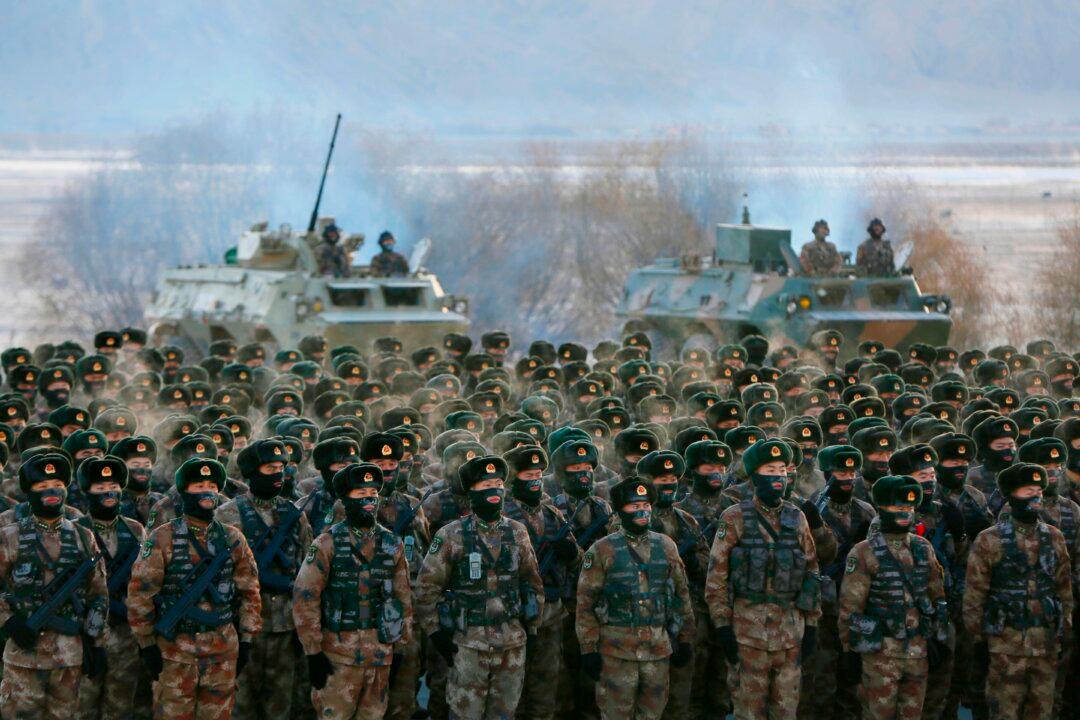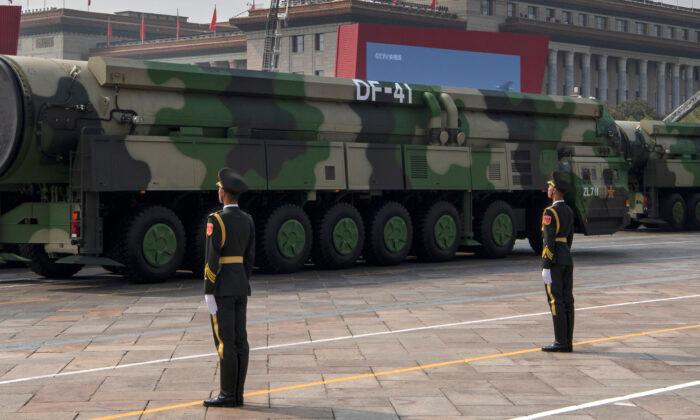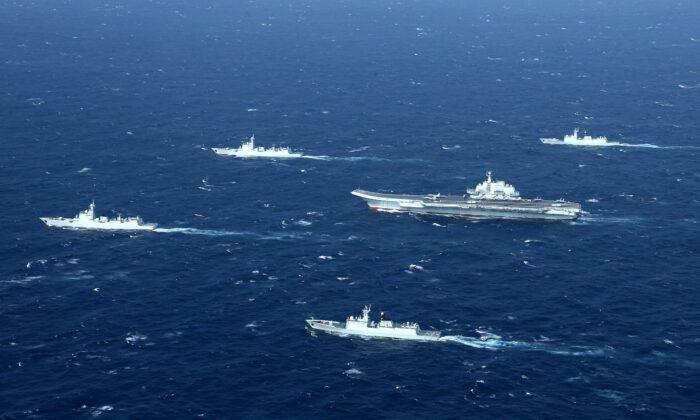The unanticipated sinking of the Moskva, the flagship of the Russian navy’s Black Sea fleet, on April 14 garnered worldwide attention. It led to intense speculation about how it will impact Russia’s ongoing war against Ukraine.
This historic sinking of this 12,000-plus ton nuclear-weapons capable Slava-class cruiser has immense implications for another area of the world: the Indo-Pacific region.
There are a number of key lessons to be learned from the sinking of the Moskva that bears directly on the survivability of the warships of the U.S. Pacific Fleet and those of America’s allies like Japan’s Maritime Self-Defense Force.
These lessons must be learned and acted upon today rather than be put off until we are in, or on, the verge of being in combat. We guarantee strategic defeat if we wait to learn these lessons in combat when our warships are at great risk of being sunk by superior Chinese navy anti-ship weapons and from the same kinds of internal inattention to detail exhibited by the Russian navy.

Defense
Under defense, the most obvious question is why the captain and crew of the Moskva were not prepared for such an attack from Ukrainian coastal defense anti-ship cruise missiles (ASCM).Part of the explanation can certainly be attributed to the Russian navy’s relative lack of practical experience with that particular threat. Unlike the U.S. Navy’s past three decades of experience conducting naval operations in the confined operating areas with a high coastal ASCM threat like the Persian Gulf, the Russian navy has not had such defensive skill-honing experience. As such, the Moskva found itself without the benefit of having an established posture for operating within the lethal threat envelope of Ukraine’s ASCMs.
Over 30 years of experience have driven the U.S. Navy to develop rigorous alert postures, focused and integrated intelligence, surveillance and reconnaissance, and defensive technologies like close-in weapons systems. Most importantly, over time, naval officers implicitly understood that if the U.S. Navy were ever in a shooting conflict, then neutralizing an adversary’s coastal missiles would be one of the highest priority targets in the earliest phase of the conflict.
By all accounts, it appears that Russia’s navy had not developed the same level of awareness and respect for Ukraine’s coastal defense missiles. This inexperience can also be applied to the apparent failure of the Russians to appreciate the importance of damage control and maintaining firebreaks and the watertight integrity of their warships. Over the years, American naval observers reported that Russian navy damage control and attention to watertight fittings and seals have more often than not been poor.
Throughout my career, the U.S. Navy placed great emphasis on material readiness, damage control, and firefighting. Yet over the past decade, there have been increasing indicators that the Navy’s high standards are slipping.
Collisions in 2017 by the USS Fitzgerald and the USS John S. McCain that resulted in the deaths of over 17 sailors, the fire and destruction of the USS Bonhomme Richard, and a spate of recent images showing rusty and unkempt warships with America’s flag aboard are more than troubling.
These recent events highlight the stress that U.S. Navy commanding officers and crews are under today in peacetime and remind Americans that Navy leaders owe these sailors the very best material readiness and most realistic training against the ASCM threat, especially in the Pacific.
When comparing the current level of upkeep of U.S. naval vessels on the front lines with the spit-polished appearance and zeal I’ve witnessed from the People’s Liberation Army Navy (PLAN), it makes me believe that PLAN ships are relatively prepared to defend themselves. Past assessments of the opposite being the cases are decades out of date. It’s well past time for the U.S. Pacific Fleet to be resourced and tested to ensure it’s equipped and troops are well trained.

What makes these defensive capabilities so important is the lethality of ASCMs, like those used to sink the Moskva. It’s important to understand that the Ukrainian subsonic Neptune coastal defense missiles that sank the Moskva are based on decades-old technology.
By comparison, China has equipped its navy, air force, and coastal defense forces with the finest ASCMs in the world for the past two decades. The PLAN today fields the supersonic YJ-18 ASCM that has a range of over 200 nautical miles. The YJ-18 is fitted on the PLAN’s latest combatants—the Type 055 cruiser and Type 0524D destroyer—and aboard its latest submarines and naval air forces.
Essentially, the PLA threatens the U.S. Pacific Fleet—but not just from China’s coastline. The American fleet is now at risk from the Chinese navy’s ASCMs throughout the first and second island chains, past Guam to an increasingly threatened Hawaii.
Offense
Other Moskva-related lessons learned deal with offense. While Moskva’s sinking was a startling demonstration of the lethal threat to modern warships posed by ASCMs—even ones based on 30-year-old technology—it would be a big mistake to come away from this event with a lopsided focus on the need for increased attention to counter-ASCM measures for U.S. Navy warships, particularly if it is effectively to the exclusion of stepped-up development and fielding of our own ASCM capabilities. Procedurally and technologically, ASCM-defense is already an extremely high priority for the U.S. Navy. It has been for decades.For instance, in the late-1990s, following the Soviet Union’s collapse, senior officials with the U.S. Navy Staff, including chiefs of naval operations, decided not to upgrade or expand the Navy’s only afloat ASCM, the Harpoon.
This attitude continued as Navy leaders moved from thinking about fighting war-at-sea as they had during the Cold War and the Reagan administration’s “maritime strategy” to the doctrine of fighting “forward … from the sea” where naval power was projected ashore from benign and safe positions off the coast of various nations in the Middle East.
Fighting at sea while fighting “from the sea” are not mutually exclusive concepts, of course, but a combination of arrogance, lack of vision, and a certain amount of political and intellectual dishonesty led to the fateful decision to divest from serious ASCM investment.

The threat posture began to change in the early 2000s, and for a decade and a half, every Pacific Fleet commander submitted requirements for fielding afloat ASCMs for the fleet. Regrettably, for two decades, Navy leadership in Washington rejected or ignored those requests.
By 2015, the need for afloat ASCMs was becoming apparent, given the increasingly menacing capabilities of the Chinese navy. But the mindset was still too focused on fighting wars in the desert and not on fighting a peer competitor navy at sea in the Western Pacific. Consequently, senior Navy and Office of the Secretary of Defense officials took a “band-aid” approach to adapt existing naval standard missiles and cruise missiles into longer-range cruise missiles that can target PLAN warships.
The problem is that these band-aid programs are all subsonic and, in many cases, are shorter range than those of the PLA navy and air force. It is not too harsh to state that the failure of defense officials to prepare the U.S. Navy for the ASCM threat is tantamount to sending the fleet to certain destruction and defeat in high-intensity combat operations that are not too far distant on the horizon.
This self-destructive mindset must be changed, and the sinking of the Moskva should be the wake-up call for this nation and the U.S. Navy.
Suppose two Soviet-era Neptune ASCMs can take out the flagship of the Russian Black Sea fleet. How do our national and Navy leaders believe in a war-at-sea to defend Taiwan (or Japan or Australia) that our fleet will stand a chance against the PLAN where every Chinese platform is equipped with vastly superior anti-ship missiles, including supersonic ASCMs?
It’s time to get serious and stop denying this reality. We must break this anti-ASCM development mindset in the Pentagon and do it now. We must start arming our warships with our own indigenously produced, superior supersonic, long-range ASCMs. That may take getting service leadership willing to put their stars/jobs on the table for this capability.
The lessons from two subsonic coastal defense ASCMs are not just for the ongoing war in Russia; they are vitally important lessons for the U.S. Pacific Fleet today. When it comes to defense, these lessons can be learned without a huge budget increase: it is about reallocating money from within the Pentagon toward ship maintenance and realistic ASCM defense training.
Again, the cost-benefit analysis is a no-brainer when it comes to offense: invest in state-of-the-art ASCM or lose billions of dollars in capital warships and the irreplaceable crews that operate our fleet. Worse, we will—without question—lose the war.
It’s time to return the U.S. Navy to be what it always has been: the greatest afloat fighting force in the world.





